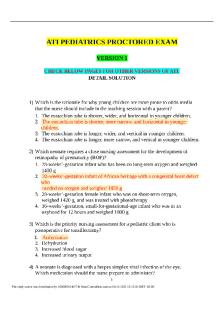Pediatrics Management PDF

| Title | Pediatrics Management |
|---|---|
| Course | Advanced Neuroscience |
| Institution | Flinders University |
| Pages | 80 |
| File Size | 4.2 MB |
| File Type | |
| Total Downloads | 85 |
| Total Views | 125 |
Summary
Lecture notes from week 1 to 8...
Description
Paeds History: • Hx: onset, duration, character, associated symptoms, medical attention thus far (Ix, Mx) • Symptom review: R/F, R/O differentials • Input/output: feeding (type e.g. breastmilk, formula; 2 weeks Most commonly due to infection or post-infectious states - Consider “Toddler’s diarrhoea” is
Causes
Common causes include: - Infection, post-infectious states - Toddler’s diarrhoea (non-specific diarrhoea during preschool age with no red flag symptoms and otherwise asymptomatic, loose stools but normal growth, reassurance and education) - Coeliac disease - IBD Otherwise, can be structured into Secretory Osmotic Inflammatory Fatty
Investigations Stool testing to discriminate different type of diarrhoea - Electrolytes, pH, reducing substances, osmotic gap - Microscopy for WBC, RBC, MCS, parasites, viruses, C. difficile toxin - Faecal fat or elastase-1
6
Symptoms
Red flags: GIT (distension, bloody diarrhoea, hospitallisation required rehydration) FTT, oedema, clubbing, muscle wasting (buttocks), nocturnal disturbances
Investigations Blood – FBC, ESR/CRP, LFT, iron studies, vitamin (D, B12, folate) Stool tests – RBC, WBC, MCS, calprotectin/S100A12 Meckel’s Diverticulum
Coeliac Disease Diagnosis: no role of GFD prior to confirmed Dx
An immunemediated enteropathy caused by a permanent Blood tests: Total sensitivity to IgA, TTg IgA, EMA gluten in IgA, deaminated genetically gliadin IgA and susceptible IgG, FBC, iron indiviiduals studies, LFT, TFT (IgG-based tests if IgA deficient and consider antigliadin if 60 years old vasospasm stroke) During: • Typical absence seizure (TAS): impaired consciousness (loses awareness), abrupt onset and finish +/clonic/tonic/atonic/automatism/autonomic features, automatism (rubbing nose, lip smacking, drooling, pupil dilation – semi purposeful moement from cerebellum) • Atypical absence seizure/focal seizure: violent limb myoclonias, hypotonia, focal signs • Short duration (5-10s) After: NO POST-ICTAL PHASE or aura Prognosis Remission: 80% remission rate, If continues after 10 years old, consider other generalised epilepsies (juvenile absence epilepsy) Social: cognitive/academic difficulties, poor social adjustment, development milestones
Progression at school PMHx FHx of seizures
Exam:
8
• •
Neurological (normal) aim to identify secondary cause of seizure (e.g. movement disorder suggestive of cerebral palsy) Differentiate between absence seizures and daydreaming by inability to impart memory and inability to respond (e.g. shout colours, clap hands)
Investigations • EEG – regular 3Hz spike-and-wave complex + can be provoked by hyperventilation (despite being a type of epilepsy) • Consider testing hearing, vision 2. Management – epileptologist + GP + paediatrician • Non-pharmacological o Parent education/reassurance/fact sheet • Typical absence seizures resolve by puberty, avoid triggers (sleep deprivation) and dangerous situations • Compliance is key! o if ~GLUT1 deficiency (ketogenic diet) o Offer extra tuition to keep up with school • Pharmacological o Continue until EEG cease to show 3Hz spike wave activity and no seizures in 2y o [1] Ethosuximide o [2] Sodium valproate, lamotrigine (better for childbearing age) o Avoid carbamazepine, gabapentin, phenytoin, phenobarbitone
9
3. ACUTE ASTHMA Case 1: 5-year-old boy, BG of frequent asthma exacerbations, presents to ED unable to speak from breathlessness. How would you manage this patient in the acute and longterm setting? Case 2: 4-year-old presents with history of recurrent cough and difficulty breathing post URTI. There is some coughing with exercise and in early morning. His father used to have “breathing difficulty” when he was young and “outgrew it”. His mother has allergic rhinitis and conjunctivitis. He has a significant history of eczema when young, which has improved. Assess and manage. Case 3: 4-year-old boy who is brought to ED by his mother who is worried about his cough, increased WOB, wheeze and fever. He suffered from similar symptoms last winter and was prescribed Ventolin by his GP. He has suffered from eczema intermittently but has otherwise been well. His mother recalls suffering from asthma as a child. Assess and manage. Issue: This boy presents with features consistent with an acute severe exacerbation of asthma. I am also concerned about DDX for acute respiratory obstruction (anaphylaxis, FB obstruction, PTX), respiratory infection (bronchiolitis, pneumonia, CF), cardiac, metabolic (DKA, sepsis) and neurological disorders (muscular dystrophies). Definition: Asthma has recurrent and variable respiratory symptoms (wheeze, SOB, cough), with reversible airflow limitation (>12% increase in FEV1 OR ≥200mL if FEV1 is...
Similar Free PDFs

Pediatrics Management
- 80 Pages

Pediatrics - Ophthalmology
- 1 Pages

Study questions pediatrics
- 16 Pages

Uworld-pediatrics study notes
- 53 Pages

Pediatrics Exam 1
- 37 Pages

NICU rotation - Pediatrics
- 4 Pages

Pediatrics 2019 ATI!!!!!!!
- 13 Pages

Pediatrics EC pharm 2
- 3 Pages

Peds notes - pediatrics
- 9 Pages

Eve Madison vSim-Pediatrics
- 17 Pages

ATI assessment B pediatrics
- 9 Pages

Pediatrics Intro to D&D
- 6 Pages

Pediatrics Exam 1 Study Guide
- 36 Pages
Popular Institutions
- Tinajero National High School - Annex
- Politeknik Caltex Riau
- Yokohama City University
- SGT University
- University of Al-Qadisiyah
- Divine Word College of Vigan
- Techniek College Rotterdam
- Universidade de Santiago
- Universiti Teknologi MARA Cawangan Johor Kampus Pasir Gudang
- Poltekkes Kemenkes Yogyakarta
- Baguio City National High School
- Colegio san marcos
- preparatoria uno
- Centro de Bachillerato Tecnológico Industrial y de Servicios No. 107
- Dalian Maritime University
- Quang Trung Secondary School
- Colegio Tecnológico en Informática
- Corporación Regional de Educación Superior
- Grupo CEDVA
- Dar Al Uloom University
- Centro de Estudios Preuniversitarios de la Universidad Nacional de Ingeniería
- 上智大学
- Aakash International School, Nuna Majara
- San Felipe Neri Catholic School
- Kang Chiao International School - New Taipei City
- Misamis Occidental National High School
- Institución Educativa Escuela Normal Juan Ladrilleros
- Kolehiyo ng Pantukan
- Batanes State College
- Instituto Continental
- Sekolah Menengah Kejuruan Kesehatan Kaltara (Tarakan)
- Colegio de La Inmaculada Concepcion - Cebu


